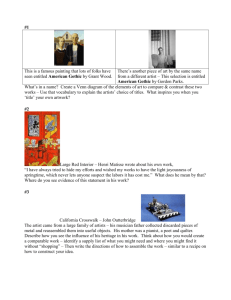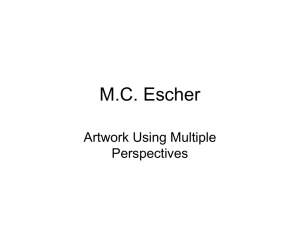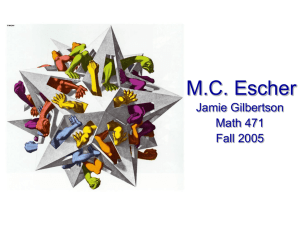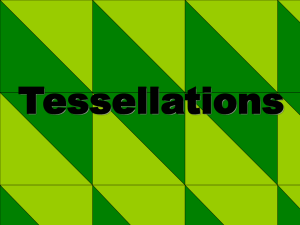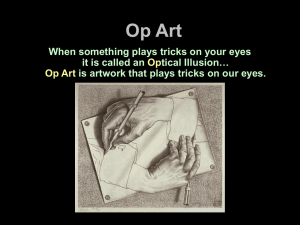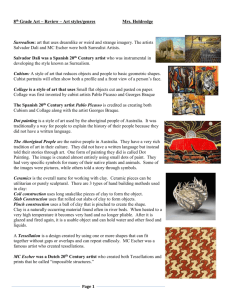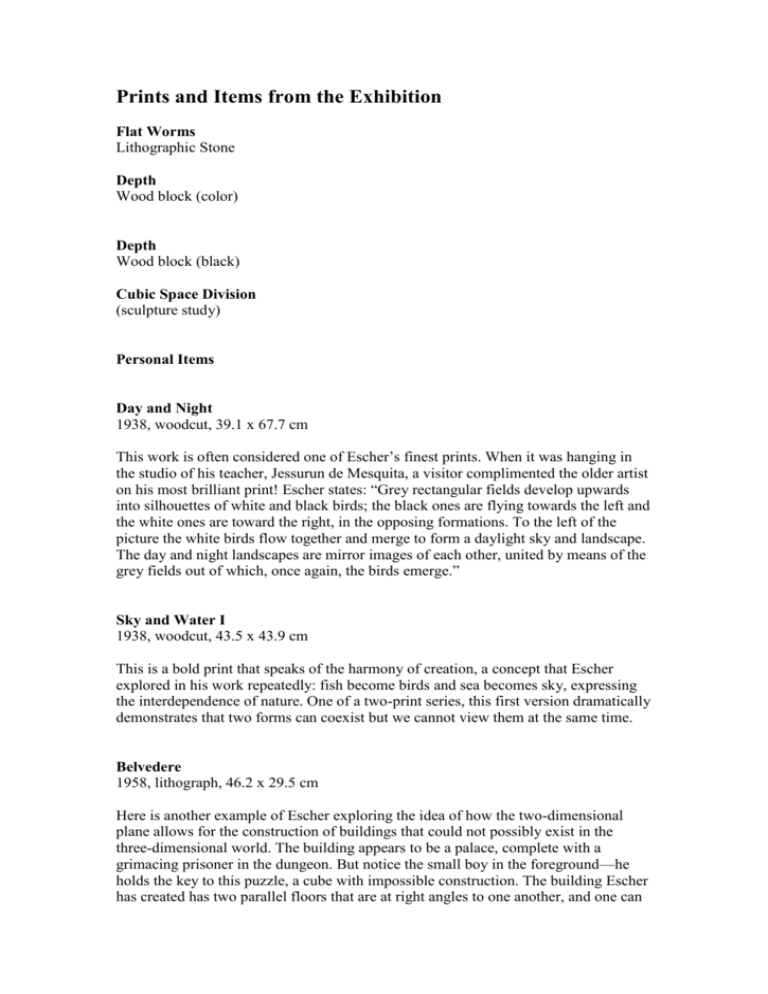
Prints and Items from the Exhibition
Flat Worms
Lithographic Stone
Depth
Wood block (color)
Depth
Wood block (black)
Cubic Space Division
(sculpture study)
Personal Items
Day and Night
1938, woodcut, 39.1 x 67.7 cm
This work is often considered one of Escher’s finest prints. When it was hanging in
the studio of his teacher, Jessurun de Mesquita, a visitor complimented the older artist
on his most brilliant print! Escher states: “Grey rectangular fields develop upwards
into silhouettes of white and black birds; the black ones are flying towards the left and
the white ones are toward the right, in the opposing formations. To the left of the
picture the white birds flow together and merge to form a daylight sky and landscape.
The day and night landscapes are mirror images of each other, united by means of the
grey fields out of which, once again, the birds emerge.”
Sky and Water I
1938, woodcut, 43.5 x 43.9 cm
This is a bold print that speaks of the harmony of creation, a concept that Escher
explored in his work repeatedly: fish become birds and sea becomes sky, expressing
the interdependence of nature. One of a two-print series, this first version dramatically
demonstrates that two forms can coexist but we cannot view them at the same time.
Belvedere
1958, lithograph, 46.2 x 29.5 cm
Here is another example of Escher exploring the idea of how the two-dimensional
plane allows for the construction of buildings that could not possibly exist in the
three-dimensional world. The building appears to be a palace, complete with a
grimacing prisoner in the dungeon. But notice the small boy in the foreground—he
holds the key to this puzzle, a cube with impossible construction. The building Escher
has created has two parallel floors that are at right angles to one another, and one can
climb a ladder from the inside to the outside of the building! And, in a rare tribute to
another artist, the individuals are an homage to the great sixteenth-century Flemish
artist Hieronymus Bosch.
Relativity
1953, lithograph, 27.7 x 29.2 cm
In Relativity, Escher not only expressed the idea that viewpoints are not fixed, but
introduces yet another concept that he would tirelessly explore: what is a ceiling to
one group is a wall to another; what is a door for one group is a trapdoor in the floor
to another. The entire environment is linked by impossible stairways, a motif
associated with Escher's work. We are compelled to follow the paths and although our
mind tells us they are impossible, we accept them as plausible. There will be one
portion of this image that will make sense visually no matter which way the print is
hung, except upside-down.
Snakes
1969, woodcut printed from three blocks, 49.8 x 44.7 cm
For this, his last print, Escher used the technique of woodcutting, which he had
favored all his life.
Waterfall
1961, lithograph, 38 x 30 cm
This print was a response to another impossible figure introduced to Escher, this one
by the mathematician Penrose. This figure is called a ‘tribar,’ an open form that when
viewed from a certain angle appears to exist as a closed triangle in real space. Here
Escher came up with a brilliant scheme, where he linked three tribars by way of
endlessly flowing water. Escher noted that the miller must add water occasionally to
compensate for evaporation.
Verbum
1942, lithograph, 33.2 x 38.6 cm
This is the only hexagonal print Escher made, and it was one of the few prints the
artist had hung in his own studio. Escher explains: “An evolution working from the
center outwards,…offers more space at the edges for the fully grown figures. The
central word “Verbum” (the Greek “Logos”) recalls the biblical story of creation. Out
of a misty grey there loom triangular primeval figures which, by the time they reach
the edges of the hexagon, have developed into birds, fishes and frogs, each in its own
element: air, water and earth. Each kind is pictured by day and by night, and the
creatures merge into each other as they move forward along the outline of the
hexagon, in a clockwise direction.”
Circle Limit IV: Heaven and Hell
1960, woodcut, 41.6 cm (diameter)
In a book by Professor H. S. M. Coxeter, Escher discovered an illustration that would
help him with his explorations of the infinite plane. This illustration expressed the
idea that the whole of an infinite plane can be shown as being within a finite circle.
From this model Escher created his own constructions of infinity in a series of prints
entitled Circle Limit, where the forms diminish in size as they move outwards. Escher
said that what he achieved was not a literal representation of infinity, “but certainly a
fragment of it.”
Reptiles
1943, lithograph, 33.4 x 38.5 cm
Among the finest prints Escher ever produced, Reptiles fascinates us with its clever
tessellation drawing from which a lizard springs to life on a circular journey that
brings it back to its origins. Every object depicted in this picture belonged to the artist,
including his tessellation sketchbook that actually has this drawing in it. These
drawings were Escher’s “visual dictionary” in which he systematically recorded every
system of interlocking figures. One of these rare watercolors is exhibited to the right
of this print.
Cycle
1938, lithograph, 47.5 x 27.9 cm
Escher explains: “At the top right-hand corner a jolly young lad comes popping out of
his house. As he rushes downstairs he loses his spacial quality and takes his place in a
pattern of flat, grey, white and black fellow-shapes. Towards the left and upwards
these become simplified into lozenges. The dimension of depth is achieved by the
combination of three diamonds which give the impression of a cube. The cube is
joined on to the house from which the boy emerges. The floor of the terrace is laid
with the same familiar pattern intended to display the utmost three-dimensional
realism, while the periodic pattern at the lower part of the picture shows the greatest
possible amount of two-dimensional restriction of freedom.”
Cubic Space Division
1952, lithograph, 26.6 x 26.6 cm
While exploring ways to represent three-dimensional space, Escher conceived this
view, a seemingly endless mechanical construction accentuated by the connecting
cubes. Intersecting each other at right angles, girders divide each other into equal
lengths, each forming the edge of a cube. In this way space is filled to infinity with
cubes of the same size.
Bond of Union
1956, lithograph, 25.3 x 33.9 cm
Escher created this double portrait of himself and his wife, Jetta, in a way that shows
both his great tenderness towards his wife and his printmaking virtuosity. One can see
inside, outside, and around the heads, while they unwind, but they are linked as one at
the forehead.
Puddle
1952, woodcut, 24 x 31.9 cm
Escher went beyond his successful Rippled Surface and created multiple reflections
while adding a human element in this picture—evidence of his storytelling abilities.
By indirect means he tells a tale that includes the reflection of the moon, the tracks of
two cars, two bicycles, and two pedestrians.
Eye
1946, mezzotint, 14.1 x 19.8 cm
This print truly defines Escher and is recognized as one of the finest mezzotints ever
created because of the subtle shading. Escher himself said that when we look deep
inside ourselves we are all looking at our own mortality. Perhaps this explains his
choice to place the skull centered in the pupil.
Up and Down (High and Low)
1947, lithograph, 50.3 x 20.5 cm
Escher says: “In this print, the same picture is presented twice over, but viewed from
two different points. The upper half shows the view that an observer would get if he
were about three storeys up; the lower half is the scene that would confront him if he
were standing at ground level. If he should take his eyes off the latter and look
upwards, then he would see the tiled floor on which he is standing, repeated as a
ceiling in the center of the composition. Yet, this acts as a floor for the upper scene.
At the very top, this tiled floor repeats itself once again, purely as a ceiling”.
Escher understood that the human eye can only focus on one area of an image at a
time and that it would be a challenge to try and visually absorb the building in its
entirety. His expert draftsmanship is shown at the center, where both images merge
seamlessly.
Drawing Hands
1948, lithograph, 28.2 x 33.2 cm
This is one of Escher’s best-known images. A piece of paper is fixed to a base with
drawing pins. A right hand is busy sketching a shirt-cuff upon this drawing paper. At
this point the work is incomplete, but a little further to the right, the hand has already
drawn a left hand emerging from a sleeve in such detail that it seems to emerge from
the flat surface. Note that Escher drew with his left hand and used his right hand as
the model.
Balcony
1945, lithograph, 29.7 x 23.4 cm
Escher’s interest in the sphere shape is seen here in his study of an image and the
distortion caused by viewing it through a sphere, creating an impossible, surreal
Italian building. Small details become large, previously unimportant areas become the
center of attention. He achieved this by enlarging the center of the print four times as
large as the area at the edges. It is a tribute to Escher that some of today’s computer
screensavers use this concept.
Print Gallery
1956, lithograph, 31.9 x 31.7 cm
What a trick Escher has achieved in this work! In this lithograph we see a depiction of
an exhibition of prints. In the bottom left-hand corner a young man views one of the
prints, a rendering of a seaside town. If one looks just below the buildings in the right
portion of the work, one notices the entrance to the gallery, beyond which is a young
man looking at the exhibited prints. Thus, the young man is himself in the print he is
looking at! Escher created this illusion by expanding the composition a total of 256
times in a clockwise circular format, beginning at the lower left corner. The same sort
of grid was used for his woodcut Fish and Scales. The artist was unable to complete
the inner portion of the print, but this has recently been accomplished. We are pleased
to show the video of this discovery.
Ascending and Descending
1960, lithograph, 35.5 x 28.5 cm
Here Escher seems to be referring to the Dutch expression “monk’s work,” meaning
tedious and endless labors. These men march up and down on their endless staircase,
though occasionally one rests on the steps below. The print also represents another
illustration of an impossible object that Escher became familiar with through an
article written by Penrose: stairs lead up and down but remain at the same level. They
are limitless and infinite--concepts important to Escher and depicted throughout his
art.
Covered Alley in Atrani, Coast of Amalfi
(from the illustrated pamphlet Halcyon)
1931, wood engraving, proof, 18 x 12.9 cm
Escher exploited the wood engraving technique to achieve the effect of a scratch
drawing, where the varying thickness of the lines creates the architectural forms.
Still Life with Mirror
1934, lithograph, 39.4 x 28.7 cm
This is perhaps the most important print the artist produced during his Italian sojourns
because it brings us directly into the unusual world of Escher. In this work two images
are revealed to us, an indoor setting and an outside world that is reflected in the
mirror. But is it a “real” world? If we look carefully, normally one should not be able
to see the street with the mirror tilted upwards. Escher intentionally breaks the rules of
landscape depiction, expecting us to discover the difference between reality and
illusion. Moreover, the artist understands our mind’s ability to accept impossible
worlds, and subtly manipulates them under his pencil.
Horses and Birds
1949, Wood engraving, 8.7 x 7.2 cm
Regular Division of the Plane IV
1957, Woodcut in red, 24 x 18 cm
Church Organ
(Large Ink Drawing)
This is a very important piece for several reasons. First, it is a very early drawing.
Although undated, it is generally assumed that he drew it around 1920, making it
among his first experiments in perspective. Secondly, the topic (a church organ), the
setting (in a cathedral) and the perspective he chose (low angle with high perspective)
give this image a dramatic appearance. Thirdly, the sheer size, the choice of black ink
and the visible pencil markings make this an excellent study of the artist's desire to
break away from the mould and see objects around him in a different light. There are
only a handful of such large drawings available for viewing.
The Bridge
1930, lithograph, 53.6 X 37.7 cm
One of many prints which were intended for a book on the Abruzzi, that never
materialized.
Old Houses of Positano
1934, lithograph, 24.5 X 28.6 cm
This is an Italian print representing scenes from another of his beloved Italian towns.
Here, Escher decided to detach the group of houses from the surrounding landscape so
that the viewer can concentrate on the architecture.
Inside St Peter's
1935, wood engraving, 23.7 ? 31.6 cm
This print presents a very unusual perspective to the viewer. Escher remarks: "The
convergence of the vertical lines towards the nadir suggests the height of the building
in which the viewer finds himself, together with the feeling of vertigo that takes hold
of him when he looks down." Another remarkable feature of this print is the level of
detail achieved in a wood engraving.
Dream / Praying Mantis
1935, wood engraving, 32.2 X 24.1 cm
Escher wants us to think about whether the bishop is dreaming of the Praying Mantis
or the artist dreamt of the whole image. Note that, in one of his letters from Italy,
Escher mentions the Praying Mantis and how it had stood immobile next to him, as if
it was modeling for him.
Stars
1948, wood engraving, 32 X 26 cm
This is only one of three prints for which Escher created a prior study: Dragon, Stars
and Snakes. Escher was deeply perplexed by how to represent space. He said of this
print: "Single, double and triple regular bodies float like stars through space. In the
midst of them is a system of three regular octahedrons, indicated by their edges only.
Two chameleons have been chosen as denizens of this framework, because they are
able to cling by their legs and tails to the beams of their cage as it swirls through
space".
Circle Limit I
1958, woodcut, diameter 41.8 cm
The first of a series of four Circle Limits of which the Iuseum has two: "Circle Limit
I" and "Circle Limit IV". In the first attempt we understand the principle he tries to
convey: to illustrate the limit of infinite smallness. The black and white fish recede
towards the outer rim. The limit is not a point, but a circle that borders the whole
complex and gives it a logical boundary and creates as it were a universe. At the end
of his career he created the ultimate Circle Limit, his last masterpiece: "Snakes".
All M.C. Escher works © 2004 The M.C. Escher Company - Baarn - Netherlands. All
rights reserved.
M.C. Escher® is a registered trademark of the M.C. Escher Foundation - Baarn Netherlands

